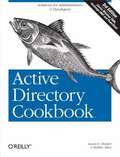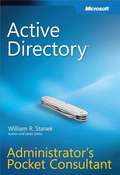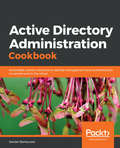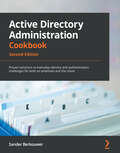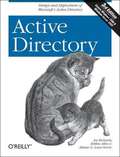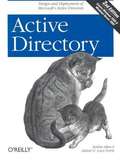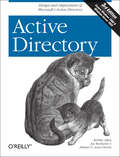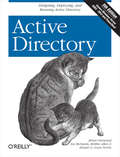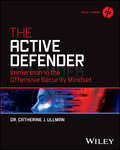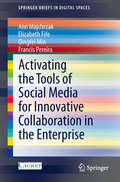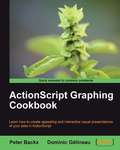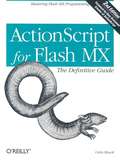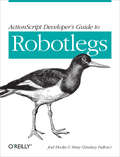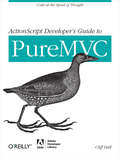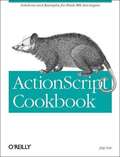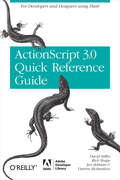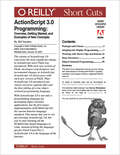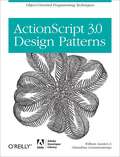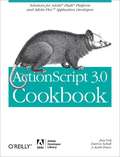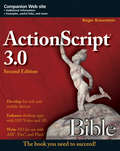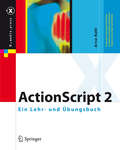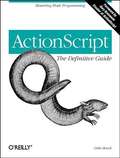- Table View
- List View
Active Directory Cookbook
by Laura E. Hunter Robbie AllenWhen you need practical hands-on support for Active Directory, the updated edition of this extremely popular Cookbook provides quick solutions to more than 300 common (and uncommon) problems you might encounter when deploying, administering, and automating Microsoft's network directory service. For the third edition, Active Directory expert Laura E. Hunter offers troubleshooting recipes based on valuable input from Windows administrators, in addition to her own experience. You'll find solutions for the Lightweight Directory Access Protocol (LDAP), ADAM (Active Directory Application Mode), multi-master replication, Domain Name System (DNS), Group Policy, the Active Directory Schema, and many other features. The Active Directory Cookbook will help you: Perform Active Directory tasks from the command line Use scripting technologies to automate Active Directory tasks Manage new Active Directory features, such as Read-Only Domain Controllers, fine-grained password policies, and more Create domains and trusts Locate users whose passwords are about to expire Apply a security filter to group policy objects Check for potential replication problems Restrict hosts from performing LDAP queries View DNS server performance statistics Each recipe includes a discussion explaining how and why the solution works, so you can adapt the problem-solving techniques to similar situations. Active Directory Cookbook is ideal for any IT professional using Windows Server 2008, Exchange 2007, and Identity Lifecycle Manager 2007, including Active Directory administrators looking to automate task-based solutions."It is rare for me to visit a customer site and not see a copy of Active Directory Cookbook on a shelf somewhere, which is a testament to its usefulness. The Cookbook takes the pain out of everyday AD tasks by providing concise, clear and relevant recipes. The fact that the recipes are provided using different methods (graphical user interface, command line and scripting) means that the book is suitable for anyone working with AD on a day-to-day basis. The introduction of PowerShell examples in this latest edition will be of particular interest for those looking to transition from VBScript. Laura has also done a great job in extending the Cookbook in this edition to encompass the broad range of changes to AD in Windows Server 2008." --Tony Murray, Founder of Activedir.org and Directory Services MVP"If you already understand Active Directory fundamentals and are looking for a quick solution to common Active Directory related tasks, look no further, you have found the book that you need." --joe Richards, Directory Services MVP"The Active Directory Cookbook is the real deal... a soup-to-nuts catalog of every administrative task an Active Directory administrator needs to perform. If you administer an Active Directory installation, this is the very first book you have to put on your shelf." --Gil Kirkpatrick, Chief Architect, Active Directory and Identity Management, Quest Software and Directory Services MVP
Active Directory® Administrator's Pocket Consultant
by William R. StanekPortable and precise, this pocket-sized guide delivers immediate answers for the day-to-day administration of Active Directory in Windows Server 2008. Zero in on core support and maintenance tasks using quick-reference tables, instructions, and lists. You'll get the focused information you need to solve problems and get the job done--whether at your desk or in the field! Get fast facts to: Install forests, domain trees, and child domains Add and remove writable domain controllers and deploy read-only controllers Configure, maintain, and troubleshoot global catalog servers Maintain directory and data integrity using operations masters Evaluate sites, subnets, and replication before expanding a network Establish a trust relationship between domains and between forests Maintain and recover Active Directory Domain Services Employ essential command-line utilities
Active Directory Administration Cookbook: Actionable, proven solutions to identity management and authentication on servers and in the cloud
by Sander BerkouwerLearn the intricacies of managing Azure AD, Azure AD Connect as well as Active Directory for administration on cloud and Windows Server 2019Key FeaturesExpert solutions for the federation, certificates, security, and monitoring with Active DirectoryExplore Azure AD and AD Connect for effective administration on cloudAutomate security tasks using Active Directory and PowerShellBook DescriptionActive Directory is an administration system for Windows administrators to automate network, security and access management tasks in the Windows infrastructure.This book starts off with a detailed focus on forests, domains, trusts, schemas and partitions. Next, you learn how to manage domain controllers, organizational units and the default containers. Going forward, you deep dive into managing Active Directory sites as well as identifying and solving replication problems. The next set of chapters covers the different components of Active Directory and discusses the management of users, groups and computers. You also go through recipes that help you manage your Active Directory domains, manage user and groups objects and computer accounts, expiring group memberships and group Managed Service Accounts with PowerShell. You learn how to work with Group Policy and how to get the most out of it. The last set of chapters covers federation, security and monitoring. You will also learn about Azure Active Directory and how to integrate on-premises Active Directory with Azure AD. You learn how Azure AD Connect synchronization works, which will help you manage Azure AD.By the end of the book, you have learned in detail about Active Directory and Azure AD, too.What you will learnManage new Active Directory features, such as the Recycle Bin, group Managed Service Accounts, and fine-grained password policiesWork with Active Directory from the command line and use Windows PowerShell to automate tasksCreate and remove forests, domains, and trustsCreate groups, modify group scope and type, and manage membershipsDelegate control, view and modify permissionsOptimize Active Directory and Azure AD in terms of securityWho this book is forThis book will cater to administrators of existing Active Directory Domain Services environments and/or Azure AD tenants, looking for guidance to optimize their day-to-day effectiveness. Basic networking and Windows Server Operating System knowledge would come in handy.
Active Directory Administration Cookbook: Proven solutions to everyday identity and authentication challenges for both on-premises and the cloud, 2nd Edition
by Sander BerkouwerSimplified actionable recipes for managing Active Directory and Azure AD, as well as Azure AD Connect, for administration on-premise and in the cloud with Windows Server 2022Key FeaturesExpert solutions for name resolution, federation, certificates, and security with Active DirectoryExplore Microsoft Azure AD and Azure AD Connect for effective administration on the cloudAutomate security tasks using Active Directory tools and PowerShellBook DescriptionUpdated to the Windows Server 2022, this second edition covers effective recipes for Active Directory administration that will help you leverage AD's capabilities for automating network, security, and access management tasks in the Windows infrastructure.Starting with a detailed focus on forests, domains, trusts, schemas, and partitions, this book will help you manage domain controllers, organizational units, and default containers. You'll then explore Active Directory sites management as well as identify and solve replication problems. As you progress, you'll work through recipes that show you how to manage your AD domains as well as user and group objects and computer accounts, expiring group memberships, and Group Managed Service Accounts (gMSAs) with PowerShell. Once you've covered DNS and certificates, you'll work with Group Policy and then focus on federation and security before advancing to Azure Active Directory and how to integrate on-premise Active Directory with Azure AD. Finally, you'll discover how Microsoft Azure AD Connect synchronization works and how to harden Azure AD.By the end of this AD book, you'll be able to make the most of Active Directory and Azure AD Connect.What you will learnManage the Recycle Bin, gMSAs, and fine-grained password policiesWork with Active Directory from both the graphical user interface (GUI) and command lineUse Windows PowerShell to automate tasksCreate and remove forests, domains, domain controllers, and trustsCreate groups, modify group scope and type, and manage membershipsDelegate, view, and modify permissionsSet up, manage, and optionally decommission certificate authoritiesOptimize Active Directory and Azure AD for securityWho this book is forThis book is for administrators of existing Active Directory Domain Service environments as well as for Azure AD tenants looking for guidance to optimize their day-to-day tasks. Basic networking and Windows Server Operating System knowledge will be useful for getting the most out of this book.
Active Directory, 3rd Edition
by Robbie Allen Joe Richards Alistair G. Lowe-NorrisWorking with Microsoft's network directory service for the first time can be a headache for system and network administrators, IT professionals, technical project managers, and programmers alike. This authoritative guide is meant to relieve that pain. Instead of going through the graphical user interface screen by screen, O'Reilly's bestselling Active Directory tells you how to design, manage, and maintain a small, medium, or enterprise Active Directory infrastructure. Fully updated to cover Active Directory for Windows Server 2003 SP1 and R2, this third edition is full of important updates and corrections. It's perfect for all Active Directory administrators, whether you manage a single server or a global multinational with thousands of servers. Active Directory, 3rd Edition is divided into three parts. Part I introduces much of how Active Directory works, giving you a thorough grounding in its concepts. Some of the topics include Active Directory replication, the schema, application partitions, group policies, and interaction with DNS. Part II details the issues around properly designing the directory infrastructure. Topics include designing the namespace, creating a site topology, designing group policies for locking down client settings, auditing, permissions, backup and recovery, and a look at Microsoft's future direction with Directory Services. Part III covers how to create and manipulate users, groups, printers, and other objects that you may need in your everyday management of Active Directory. If you want a book that lays bare the design and management of an enterprise or departmental Active Directory, then look no further. Active Directory, 3rd Edition will quickly earn its place among the books you don't want to be without.
Active Directory, 2nd Edition
by Robbie Allen Alistair G. Lowe-NorrisActive Directory, 2nd Edition, provides system and network administrators, IT professionals, technical project managers, and programmers with a clear, detailed look at Active Directory for both Windows 2000 and Windows Server 2003. Active Directory, 2nd Edition will guide you through the maze of concepts, design issues and scripting options enabling you to get the most out of your deployment.
Active Directory, 2nd Edition
by Robbie Allen Alistair G. Lowe-NorrisWhen Microsoft introduced Windows 2000, the most important change was the inclusion of Active Directory. With many great benefits, it continues to be a huge headache for network and system administrators to design, implement and support. The first edition of this book, O'Reilly's best-selling Windows 2000 Active Directory , eased their pain considerably. Now titled Active Directory , 2nd Edition, this book provides system and network administrators, IT professionals, technical project managers, and programmers with a clear, detailed look at Active Directory for both Windows 2000 and Windows Server 2003. The upgraded Active Directory that ships with Windows Server 2003 has over 100 new and enhanced features and once again, O'Reilly has the answers to puzzling questions. While Microsoft's documentation serves as an important reference, Active Directory , 2nd Edition is a guide to help the curious (and weary) understand the big picture. In addition to the technical details for implementing Active Directory, several new and significantly enhanced chapters describe the numerous features that have been updated or added in Windows Server 2003 along with coverage of new programmatic interfaces that are available to manage it. After reading the book you will be familiar with the Lightweight Directory Access Protocol (LDAP), multi-master replication, Domain Name System (DNS), Group Policy, and the Active Directory Schema, among many other topics. Authors Robbie Allen and Alistair G. Lowe-Norris are experienced veterans with real-world experience. Robbie is a Senior Systems Architect in the Advanced Services Technology Group at Cisco Systems. He was instrumental in the deployment and automation of Active Directory, DNS and DHCP at Cisco, and is now working on network automation tools. Alistair is an enterprise program manager for Microsoft U.K. and previously worked for Leicester University as the project manager and technical lead of the Rapid Deployment Program for Windows 2000. Active Directory , 2nd Edition will guide you through the maze of concepts, design issues and scripting options enabling you to get the most out of your deployment.
Active Directory
by Alistair G. Lowe-Norris Robbie Allen Joe RichardsWorking with Microsoft's network directory service for the first time can be a headache for system and network administrators, IT professionals, technical project managers, and programmers alike. This authoritative guide is meant to relieve that pain. Instead of going through the graphical user interface screen by screen, O'Reilly's bestselling Active Directory tells you how to design, manage, and maintain a small, medium, or enterprise Active Directory infrastructure. Fully updated to cover Active Directory for Windows Server 2003 SP1 and R2, this third edition is full of important updates and corrections. It's perfect for all Active Directory administrators, whether you manage a single server or a global multinational with thousands of servers. Active Directory, 3rd Edition is divided into three parts. Part I introduces much of how Active Directory works, giving you a thorough grounding in its concepts. Some of the topics include Active Directory replication, the schema, application partitions, group policies, and interaction with DNS. Part II details the issues around properly designing the directory infrastructure. Topics include designing the namespace, creating a site topology, designing group policies for locking down client settings, auditing, permissions, backup and recovery, and a look at Microsoft's future direction with Directory Services. Part III covers how to create and manipulate users, groups, printers, and other objects that you may need in your everyday management of Active Directory. If you want a book that lays bare the design and management of an enterprise or departmental Active Directory, then look no further. Active Directory, 3rd Edition will quickly earn its place among the books you don't want to be without.
Active Directory: Designing, Deploying, and Running Active Directory
by Alistair G. Lowe-Norris Robbie Allen Joe Richards Brian DesmondTo help you take full advantage of Active Directory, this fourth edition of this bestselling book gives you a thorough grounding in Microsoft's network directory service. With Active Directory, you'll learn how to design, manage, and maintain an AD infrastructure, whether it's for a small business network or a multinational enterprise with thousands of resources, services, and users. This detailed and highly accurate volume covers Active Directory from its origins in Windows 2000 through Windows Server 2008. But unlike typical dry references, Active Directory presents concepts in an easy-to-understand, narrative style. With this book, you will: Get a complete review of all the new Windows 2008 features Learn how Active Directory works with Exchange and PowerShell Take advantage of the updated scripting and programming chapters to automate AD tasks Learn how to be more efficient with command-line tools Grasp concepts easily with the help of numerous screenshots and diagrams Ideal for administrators, IT professionals, project managers, and programmers alike, Active Directory is not only for people getting started with AD, it's also for experienced users who need to stay up-to-date with the latest AD features in Windows Server 2008. It is no wonder this guide is the bestselling AD resource available.
The Active Defender: Immersion in the Offensive Security Mindset
by Dr. Catherine J. UllmanImmerse yourself in the offensive security mindset to better defend against attacks In The Active Defender: Immersion in the Offensive Security Mindset, Senior Information Security Forensic Analyst Dr. Catherine J. Ullman delivers an expert treatment of the Active Defender approach to information security. In the book, you’ll learn to understand and embrace the knowledge you can gain from the offensive security community. You’ll become familiar with the hacker mindset, which allows you to gain emergent insight into how attackers operate and better grasp the nature of the risks and threats in your environment. The author immerses you in the hacker mindset and the offensive security culture to better prepare you to defend against threats of all kinds. You’ll also find: Explanations of what an Active Defender is and how that differs from traditional defense models Reasons why thinking like a hacker makes you a better defender Ways to begin your journey as an Active Defender and leverage the hacker mindsetAn insightful and original book representing a new and effective approach to cybersecurity, The Active Defender will be of significant benefit to information security professionals, system administrators, network administrators, and other tech professionals with an interest or stake in their organization’s information security.
Activating the Tools of Social Media for Innovative Collaboration in the Enterprise (SpringerBriefs in Digital Spaces)
by Ann Majchrzak Elizabeth Fife Qingfei Min Francis PereiraThe use of social media tools in the enterprise is expanding rapidly and yet, firms are still unclear about the overall value of this activity and how best to facilitate useful outcomes. The focus of this book is, from a managerial standpoint, the control of information, the extent to which such tools can enhance employee satisfaction and how best to use social media tools to attain specific outcomes including innovative collaboration. As companies turn to IT solutions as substitutes for face-to-face engagements, an understanding of the social dynamics - how employees can best communicate, find and use information and generate motivation through computer-mediated activities is fundamental. Lingering questions relate to the strategic use of these tools; many large companies are using Facebook-like applications due to employee demand, but are not studying outcomes comprehensively or managing processes to create desired outcomes. This book fills this knowledge gap through examining the process and results of a controlled study in two companies, one in the US and the other in China. In each company "wiki challenges" were introduced to employees who were provided guidelines to produce goal-oriented outcomes. The book examine the results in each case and suggest guidelines for firms to achieve "wiki-readiness" to support innovation and co-creation.
ActionScript Graphing Cookbook
by Peter Backx Dominic GélineauStep-by-step instructions guide you from your very first graphical program to highly complex 3D presentations. Although a few recipes explain charts in Flex, this book is firmly focussed on using ActionScript code and data to draw graphs. The "ActionScript Graphing Cookbook" is aimed at any ActionScript developer who wants to add data visualization to their skill set. The reader should be familiar with ActionScript basics, but no deep knowledge of any graphical functions is required.
ActionScript for Flash MX: The Definitive Guide, 2nd Edition
by Colin MoockActionScript for Flash MX: The Definitive Guide is the most complete, up-to-date reference available for the latest version of ActionScript. Author Colin Moock has added hundreds of new code examples to show new Flash MX techniques in the real world. The book's language reference alone has nearly doubled from the first edition, with more than 250 new classes, objects, methods, and properties. You'll find exhaustive coverage of dozens of undocumented, under-documented, and mis-documented features.
ActionScript for Flash MX: The Definitive Guide, 2nd Edition
by Colin MoockUpdated to cover Flash MX, the newest version of Macromedia Flash, ActionScript for Flash MX: The Definitive Guide , Second Edition is the one book no serious Flash developer should be without. ActionScript is Macromedia's programming language for Flash MX, the popular authoring tool for creating rich internet applications and animations for the Web. With Macromedia's new focus on application development, ActionScript now includes a direct drawing API, loading of external MP3 and JPG files, improved sound control, an extensive set of text formatting tools, complete support for component development using movie clip subclasses, local data storage, accessibility features, and much more. And ActionScript for Flash MX: The Definitive Guide is the most complete, up-to-date reference available for the latest version of this language. Author Colin Moock, one of the most universally respected developers in the Flash community, has added hundreds of new code examples to show new Flash MX techniques in the real world: how to draw circles, save data to disk, convert arrays to onscreen tables, create reusable components, and preload variables, XML, and sounds. The book's language reference alone has nearly doubled from the first edition, with more than 250 new classes, objects, methods, and properties. You'll find exhaustive coverage of dozens of undocumented, under-documented, and mis-documented features. Along with the new material, Colin Moock has meticulously revised the entire text to conform to Flash MX best-coding practices. In particular, objected-oriented programming and the new event model get special attention in light of changes to Flash MX ActionScript. From sending data between two movies to creating getter/setter properties, the new edition of this book demystifies the often-confusing new features of Flash MX, giving developers easy access to its powerful new capabilities. ActionScript for Flash MX: The Definitive Guide is structured so non-programmers can learn how to use ActionScript and programmers can take their skills to new heights. If you are in the market to really learn about the hows and whys of ActionScript, then this is the book for you.
ActionScript Developer's Guide to Robotlegs: Building Flexible Rich Internet Applications (Oreilly And Associate Ser.)
by Joel Hooks StrayRobotlegs is a standout among the ActionScript 3 development frameworks available today. With it, Flash, Flex, and AIR developers can create well-architected, testable, and flexible Rich Internet Applications--fast. This concise guide shows you how the light footprint and focused scope of this open source framework not only solves your immediate coding problems, it helps you gain insight into AS3 architecture on a much deeper level. The authors provide a walkthrough of specific features in two applications they've written in Robotlegs, complete with code for each application as a whole. You'll learn how to achieve a balance of flexibility and consistency in your own projects. Solve 80% of your coding problems with 20% of the API Gain code-base flexibility with automated Dependency Injection Learn the anatomy of a Robotlegs application Understand the relationships between models, services, control code, and views in the framework's MVCS architecture See how the Robotlegs' approach facilitates Test Driven Development (TDD) Pick up practical methods for architecting Robotlegs solutions Get expert insights to power-up your existing Robotlegs code
ActionScript Developer's Guide to PureMVC: Code at the Speed of Thought
by Cliff Hall<p>PureMVC is a popular framework that helps developers to implement a Model-View-Controller architecture in their applications. This book teaches the fundamentals of development with PureMVC in the context of a complete Adobe AIR application. Over the course of the book, you will become familiar with all the framework classes and the best practices for their use in your day-to-day work.</p>
ActionScript Cookbook
by Joey LottActionScript's sheer volume of capabilities can be daunting. The ActionScript Cookbook breaks it all down into tasks that are relevant, practical, and insightful. On top of hundreds of atomic recipes, it offers seven full chapters of larger sample applications. Appealing to all levels of ActionScript coders, this book offers concrete solutions to the most common ActionScript needs and problems. The ActionScript Cookbook is for people who want to hit the ground running.
The ActionScript 3.0 Quick Reference Guide
by Darren Richardson Jen Dehaan Rich Shupe David StillerThis reference guide for ActionScript 3. 0 is aimed at Flash designers and developers who are currently using the 2. 0 version and need to adjust to the revisions and improvements as quickly as possible. Stiller, Shupe and Richardson are noted computer authors, and they are joined by deHaan, a software quality engineer for Adobe. Together they provide object-oriented programming tips that illustrate the player enhancements, workflow differences and new features while outlining the changes to the old 2. 0 features. A free online edition of this guide is available for 45 days after the purchase of this book. Annotation ©2009 Book News, Inc. , Portland, OR (booknews. com)
The ActionScript 3.0 Quick Reference Guide: For Developers and Designers Using Flash CS4 Professional (Adobe Developer Library)
by Rich Shupe Darren Richardson Jen Dehaan David Stiller"No matter what your background, the pages that follow will provide you with some excellent knowledge, insight, and even a little bit of wisdom in the realm of Flash and ActionScript. Happy learning!" -- Branden Hall, from the Foreword Written by Flash insiders with extensive knowledge of the technology, this guide is designed specifically to help Flash designers and developers make the leap from ActionScript 2.0 to the new object-oriented ActionScript 3.0 quickly and painlessly. Formatted so you can find any topic easily, ActionScript 3.0 Quick Reference Guide explains: Object-oriented programming (OOP) concepts, such as packages and classes ActionScript 3.0 features and player enhancements that improve performance Workflow differences between ActionScript 2.0 and ActionScript 3.0 including tools, code editing, component sets, and image and font rendering Where did it go? A guide to help you find familiar features in ActionScript 3.0, such as global functions, operators, properties, and statements How do I? Step-by-step solutions for performing tasks with ActionScript 3.0, including input, sound, video, display, events, text, and more Also included are overviews of Flash and ActionScript features and workflows. ActionScript 3.0 is a huge upgrade to Flash's programming language -- and this guide helps you upgrade your skills to match it.
ActionScript 3.0 Programming: Overview, Getting Started, and Examples of New Concepts
by William SandersActionScript 3.0 Programming: Overview, Getting Started, and Examples of New Concepts is a 76-page document designed to introduce those familiar with general programming principles to ActionScript 3.0. ActionScript 3.0 compiles and runs much faster than preceding versions, and the reasons have much to do with the structural changes Adobe has added: You truly do need to use ActionScript differently than you have previously, if you're already ActionScript programmer. If you're new to ActionScript, but are looking at it from a Java or C++ or C# perspective, you may be intrigued at how different ActionScript is now compared with what you'd known it or heard it to be before.This document employs reusable code examples to demonstrate the basic functionality of ActionScript 3.0 in the following topic areas: Packages and Classes; Display Programming; Movie Clips and Buttons; and Basic Structures. A concluding section helps those unfamiliar with OOP (Object Oriented Programming) and Design Patterns get acquainted with these concepts, as a knowledge of them will greatly benefit anyone getting into ActionScript 3.0 who wants to get the most out of it.
ActionScript 3.0 Design Patterns
by William Sanders Chandima CumaranatungeNow that ActionScript is reengineered from top to bottom as a true object-oriented programming (OOP) language, reusable design patterns are an ideal way to solve common problems in Flash and Flex applications. If you're an experienced Flash or Flex developer ready to tackle sophisticated programming techniques with ActionScript 3.0, this hands-on introduction to design patterns is the book you need.ActionScript 3.0 Design Patterns takes you step by step through the process, first by explaining how design patterns provide a clear road map for structuring code that actually makes OOP languages easier to learn and use. You then learn about various types of design patterns and construct small abstract examples before trying your hand at building full-fledged working applications outlined in the book. Topics in ActionScript 3.0 Design Patterns include: Key features of ActionScript 3.0 and why it became an OOP language OOP characteristics, such as classes, abstraction, inheritance, and polymorphism The benefits of using design patterns Creational patterns, including Factory and Singleton patterns Structural patterns, including Decorator, Adapter, and Composite patterns Behavioral patterns, including Command, Observer, Strategy, and State patterns Multiple design patterns, including Model-View-Controller and Symmetric Proxy designs During the course of the book, you'll work with examples of increasing complexity, such as an e-business application with service options that users can select, an interface for selecting a class of products and individual products in each class, an action game application, a video record and playback application, and many more. Whether you're coming to Flash and Flex from Java or C++, or have experience with ActionScript 2.0, ActionScript 3.0 Design Patterns will have you constructing truly elegant solutions for your Flash and Flex applications in no time.
ActionScript 3.0 Cookbook
by Joey Lott Darron Schall Keith PetersWell before Ajax and Microsoft's Windows Presentation Foundation hit the scene, Macromedia offered the first method for building web pages with the responsiveness and functionality of desktop programs with its Flash-based "Rich Internet Applications". Now, new owner Adobe is taking Flash and its powerful capabilities beyond the Web and making it a full-fledged development environment. Rather than focus on theory, the ActionScript 3.0 Cookbook concentrates on the practical application of ActionScript, with more than 300 solutions you can use to solve a wide range of common coding dilemmas. You'll find recipes that show you how to: Detect the user's Flash Player version or their operating system Build custom classes Format dates and currency types Work with strings Build user interface components Work with audio and video Make remote procedure calls using Flash Remoting and web services Load, send, and search XML data And much, much more ... Each code recipe presents the Problem, Solution, and Discussion of how you can use it in other ways or personalize it for your own needs, and why it works. You can quickly locate the recipe that most closely matches your situation and get the solution without reading the whole book to understand the underlying code. Solutions progress from short recipes for small problems to more complex scripts for thornier riddles, and the discussions offer a deeper analysis for resolving similar issues in the future, along with possible design choices and ramifications. You'll even learn how to link modular ActionScript pieces together to create rock-solid solutions for Flex 2 and Flash applications. When you're not sure how ActionScript 3.0 works or how to approach a specific programming dilemma, you can simply pick up the book, flip to the relevant recipe(s), and quickly find the solution you're looking for. Adobe Developer Library is a co-publishing partnership between O'Reilly Media and Adobe Systems, Inc. and is designed to produce the number one information resources for developers who use Adobe technologies. Created in 2006, the Adobe Developer Library is the official source for comprehensive learning solutions to help developers create expressive and interactive web applications that can reach virtually anyone on any platform. With top-notch books and innovative online resources covering the latest in rich Internet application development, the Adobe Developer Library offers expert training and in-depth resources, straight from the source.
ActionScript 3.0 Bible (Bible #617)
by Roger BraunsteinThe updated edition on all the latest features and capabilities of ActionScript 3.0 and Flash Player 10. ActionScript is a popular programming language used primarily for the development of Web sites and software. This update to the successful previous version introduces you to all the exciting new capabilities of ActionScript 3.0. You'll see how ActionScript 3.0 goes beyond its primary use of scripting Flash animations and is now an object-oriented evolution that runs ten times faster than previous versions and can be used in Adobe's new platforms, including Flex and AIR. Hands-on instruction and step-by-step tutorials enhance your learning process as you discover everything you need to know in order to harness the power of ActionScript 3.0. You'll learn the nitty gritty of building Rich Internet Applications (RIA) and the ins and outs of putting the new features of ActionScript 3.0 to work for you. ActionScript 3.0 goes beyond its original role as a scripting language and has added development features, incredible speed, and the ability to work with Flex and AIR Shows you how to apply advanced graphic effects using Pixel Blender Demonstrates the all-new text and typography capabilities Addresses your new enhanced control over dynamic sound Explains templated types and new vector data structures ActionScript 3.0 Bible offers you a soup-to-nuts guide on all things ActionScript 3.0 so you can get started working with it immediately.
ActionScript 2: Ein Lehr- und Übungsbuch (X.media.press)
by Arno KohlFlash und ActionScript sind aus der Gestaltung interaktiver Websites nicht mehr wegzudenken. Autor Arno Kohl von der "Macromedia Akademie für Medien", ist Experte auf dem Gebiet. In Teil 1: Programmierkonzepte sowie die Strukturen der Scriptsprache ActionScript (AS) anhand praktischer Übungsbeispiele. In Teil 2: Workshops zur Erstellung einer Website inkl. spezifischer Elemente - komplexe Preloader, gescriptete (Animations-)Effekte, XML generierte dynamische Menüs, modularer Aufbau mit swf, Bildgalerie, Templates, Spiele, Komponenten. Wer Grundkenntnisse in Actionscripting besitzt, kann die Workshops (auf CD-ROM) schrittweise nachvollziehen.
ActionScript: The Definitive Guide
by Colin MoockGiven its ability to deliver high-impact experiences even over low-bandwidth connections, Flash has become the de facto standard for hundreds of thousands of multimedia web developers worldwide. Flash 5 now includes a new full-fledged programming language called "ActionScript" for controlling animation and multimedia. It's a quantum leap from the bare-bones "Actions" supported in Flash 4, and ActionScript: The Definitive Guide is the first book dedicated entirely to documenting and demonstrating this new language. ActionScript includes all fundamental programming constructs (variables, loops, conditionals, functions, etc.), and is inextricably fused with Flash's authoring behaviors and animation timelines. Because ActionScript is based heavily on the ECMAScript Language Specification (ECMA-262) and is syntactically nearly identical to JavaScript, Macromedia expects thousands of existing JavaScript programmers to migrate to ActionScript. This book is divided into three sections. "ActionScript Fundamentals" introduces both programmers and non-programmers to the new language by first describing fundamental programming concepts and then delineating in detail the components, syntax, and usage of ActionScript. "Applied ActionScript Code Depot" shows you how to use common applications, such as processing online forms. "Language Reference" is a concise and detailed reference that makes all ActionScript globals, properties, and objects, including extensive implementation samples, easy to find quickly. Step-by-step tutorials of the most common ActionScript behaviors Object-oriented programming in Flash Intelligent interface development Server communication Dynamic content generation Password protection String handling Message boards Basic physics Games Code samples are also available from the "Code Depot" on the author's web site devoted to Flash developers. Topics covered in this book include: ActionScript: The Definitive Guide is structured so both programmers and non-programmers can learn how to use ActionScript. This book will take you well beyond simple Flash animations so you can create your own enhanced Flash-driven sites.
